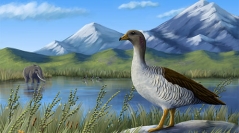

 Comptes Rendus Palevol
23 (18) - Pages 241-255
Comptes Rendus Palevol
23 (18) - Pages 241-255The genus Chloephaga Eyton, 1838, consisting of four species that breed in Patagonia, encompasses anatids endemic to South America. Despite their prominence in the present-day avifauna, these species have left behind a limited fossil record. The aim of the present contribution is to describe Chloephaga fossils coming from Middle Pleistocene levels (San José Sequence) cropping out at Bajo San José site, southwestern Buenos Aires Province, Argentina. The specimens are referred to three different taxa, including a new species, Chloephaga dabbenei n. sp., a smaller but indeterminate taxon, which is also probably a new species, and the extant species C. picta (J.F.Gmelin, 1789). The newly described species is notably large, falling within the upper size range observed in males of C. picta. The tarsometatarsus is straight-shafted with poorly divergent distal trochleae, features that are correlated with cursorial habits, that are absent in other members of Chloephaga. The co-occurrence of three species of the genus Chloephaga is registered nowadays in the Argentine Patagonia and in the southeast of Buenos Aires Province, when they migrate during the winter season.
Sheldgoose, Tadorninae, fossil diversity, Buenos Aires Province, Quaternary, new species